AUGUSTA — A 6-year-old girl from Benton has died from this year’s flu strain, which health officials warned would be severe. Hers was the first flu fatality in Maine since 2010.
“My heart goes out to the family, the community and the school that has suffered this tragic loss,” said Dr. Sheila Pinette, director of the Maine Center for Disease Control and Prevention.
In a health alert released Tuesday, Pinette said there has been a steadily increasing number of influenza cases in November and December, with 13 outbreaks recorded so far. Some of the cases have resulted in hospitalization, which Pinette said is an indicator of the severity of the illness this season.
Pinette urged all Maine residents to get flu vaccinations this year.
“It is very rare for a child that’s healthy to die from the flu, but this is a reminder,” Pinette said.
The girl, Avery Lane, a first-grade student at Benton Elementary School, died last week. Her grandmother, Pam Souzer, called Avery “very kind, very loving.”
The death of Avery, who has five siblings, stunned the school community. Principal Suanne Giorgetti sent a letter to parents Dec. 12 that said the school had “experienced the unthinkable.”
The death is a reminder that influenza is a health concern for people of all ages.
It’s rare that people die from the flu, rarer still when that person is young and healthy and not elderly and frail. During the 2011-12 flu season, there were only 34 deaths among children under the age of 18 in the entire country, according to the U.S. Centers for Disease Control and Prevention. That was the lowest number of pediatric deaths reported during a flu season since records started being kept.
Since 2005, there have been just five pediatric flu deaths reported in Maine. Pinette said this year’s death serves as a sobering reminder that everyone over the age of 6 months should be vaccinated.
The federal Centers for Disease Control estimates that 20 percent of the country’s residents will get the flu this year. More than 200,000 will be hospitalized.
“We can’t predict the severity year to year, but we have already had more outbreaks reported to date than we did during the entire 2011-12 flu season,” Pinette said.
Those at highest risk are children under the age of 5, adults over the age of 65, pregnant women and people who have underlying medical conditions.
Flu vaccines are readily available, unlike in some past years, and can be taken as a nasal spray or as a shot. The vaccine takes two weeks to work. It’s not foolproof, but it generally guards against most flu strains.
“It’s really important — especially as we enter into the holiday season when people are exposed to a lot more — to give the gift of health to each other,” Pinette said.
She also said people should wash their hands, cover coughs with tissues or sleeves and stay home when sick.
Two flu strains, influenza A/H3 and influenza B, have been confirmed in the state so far this year. According to the center, the vaccine appears to be a good match to those strains, which can make vaccination more effective.
Most doctor’s offices and many drugstores offer flu shots. Children can get flu shots at no cost.
Bob Barrett, a registered nurse at the Portland Community Free Clinic, said the clinic has administered 87 shots so far this flu season, five more than all of last year.
“There are some people who say ‘I never get the flu,’ some say ‘I got sick the last time I had a shot,’ ” Barrett said. “All those anecdotal reasons add up, but what I tell people is that it’s a probability. It will give you a better chance.”
Flu season usually peaks in January and February but can last into May. Signs of the flu include fever, cough, sore throat, runny nose, body aches, headaches and fatigue.
The Maine CDC reported the first flu cases in November, which is relatively early, and they stretched from Aroostook County south to Cumberland County. Although most flu cases are confirmed by rapid tests in doctor’s offices or clinics — and don’t have to be reported to the Maine Center for Disease Control — state health officials have been able to confirm a number of cases this year by taking cultures.
States are not required to report flu deaths unless the victim is under the age of 18, so actual deaths are hard to quantify. Some national estimates show that as many as 90 percent of flu deaths involve the elderly.
The number of pediatric deaths peaked at 282 deaths during the 2009-2010 season, which included pediatric deaths occurring during the 2009 H1N1 pandemic. The CDC said it’s possible that additional deaths will be reported for the 2011-2012 season because delays in reporting sometimes occur.
— Morning Sentinel Staff Writer Matt Hongoltz-Hetling contributed to this report.
Staff Writer Eric Russell can be contacted at 791-6344 or at:
erussell@pressherald.com
Twitter: @PPHEricRussell
Send questions/comments to the editors.


